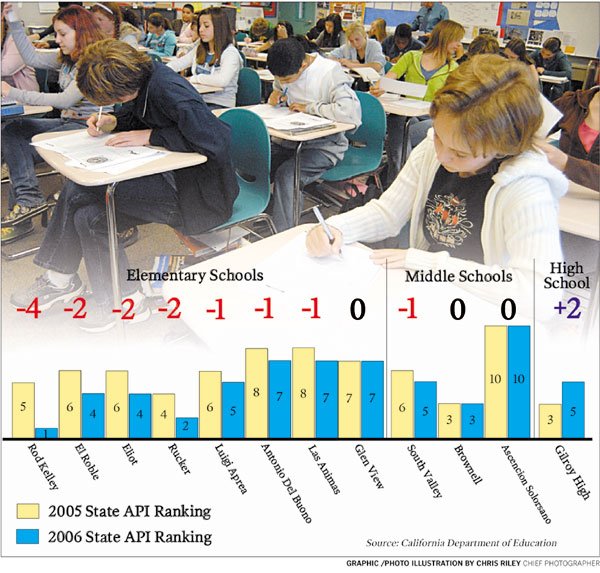Gilroy
– They come from similar neighborhoods. Their families live on
roughly the same income. Their teachers have the same
experience.
Gilroy – They come from similar neighborhoods. Their families live on roughly the same income. Their teachers have the same experience. Yet students at eight of 12 district schools are doing worse academically than their peers elsewhere, a state report revealed Tuesday.
Although most Gilroy schools posted academic gains in 2006, the gains were smaller than those seen at other schools with students from similar ethnic and socioeconomic backgrounds and with teachers of similar credentials, the report showed.
“We’re not accelerating as fast as some of our peer schools,” said Tom Bundros, president of the Gilroy Unified School District board of trustees. “I’m concerned about that.”
Last year saw the highest number of Gilroy schools to experience slower performance improvement since California began comparing schools against each other using the Academic Performance Index in 1999. The API measures the amount of learning students post from one year to the next, as measured by the State Testing and Reporting exam.
District Searching for Answers
The district was caught off-guard by the results, issuing a press release Tuesday that commented primarily on the academic gains schools made and not why district schools fared so poorly in comparison to similar schools.
“Of the 12 GUSD schools receiving API rankings … 10 surpassed their statewide API base growth targets and moved up one point on the 10-point comparative ranking scale (against schools statewide),” the press release stated.
It neglected to mention the eight schools that dropped a total of 14 points when compared with similar schools. It did, however, acknowledged that these rankings exist, but did not report the ranks of the schools.
Bundros, who saw both the data and the press release, said that to make any conclusions on the state of the district, he needed more information from Marilyn Ayala, director of curriculum and instruction, and Gail Donovan, director of assessment.
Ayala did not return phone calls. However, she was looking into the scores, the press release stated.
The district was still in the early stages of digesting the results, said Trustee Pat Midtgaard. However, she ventured that the drop in similar school rankings could have been the result of a stellar results from English language learners or special education students in other districts.
“Perhaps maybe some of the sub-groups came in higher,” she said.
The downfall in the rankings might have come from the district schools being compared to completely different schools from the year before, suggested the press release.
The comparison group changes every year according to which schools are most like the school being measured, a California Department of Education information sheet stated.
Five Below Average
The declines that district schools witnessed brought five of them into a class where they were “below” or “well-below average … for schools with similar characteristics,” according to the state publication.
Schools in a comparison group are sorted from one to 100 according to their academic gains. The schools are then scored on a 10-point scale according to their place, with 10 the highest.
Rod Kelley fared the worst in the district its comparison group – which included better-performing El Roble Elementary and Morgan Hill’s San Martin/Gwinn Elementary – dropping from five points in 2005 to one point in 2006. Similarly, Rucker Elementary dropped from a four in 2005 to a two in 2006. The state characterized these final rankings as “well-below average.”
The two bright spots of the district were Gilroy High School, which gained two points to move from “below average” to “average,” and Ascencion Solorsano Middle School, which managed to stay at the top of its class, scoring 10 points-as it did last year.
Moving Forward
The drop in rankings compared to similar schools does not take away from the academic gains district schools made, Bundros said.
“A gain is a gain,” he said. “We’re not talking about treading water or going backwards. We’re talking a difference in acceleration.”
This failure to keep up with other schools’ acceleration should not be daunting, but a learning opportunity, said Trustee Pat Midtgaard.
“The next step is to get more information regarding the 100 similar schools and why some of our schools took a sizable drop in some rankings,” she said. “And I’m sure that’s what every staff is doing now.”
The results of this inquiry into the similar school rankings will be anticipated, said Bundros.
“What I’ll be looking for from staff is for them to go in there and look to see what the other schools are doing that may account for that greater rate of acceleration,” he said.















